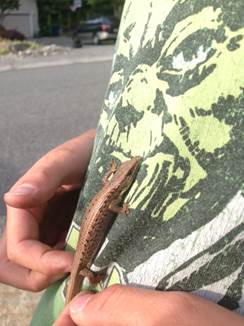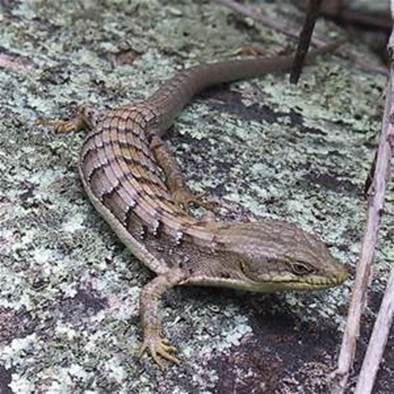Precisely the least, the softest, lightest, a lizard’s rustling, a breath, a flash, a moment – a little makes the way of the best happiness – Friedrich Nietzsche
This is a relatively common lizard of the Puget Sound region and can be found in northern Idaho, western Montana, and along the Pacific coast of southern British Columbia, Washington, Oregon, and northern and central California. They tend to live in grassy, bushy, or rocky openings within the forest or at the forest edge. They can be somewhat tolerant of low levels of development and will make use of rock retaining walls, woody debris, and rock piles adjacent to houses. There are six species in North America with in the genus Elgaria.
Coincidently I recently received a photo of an alligator lizard captured by some budding herpetologists in Ryan’s garage:

These are medium-sized slender lizards and adults reach a total length of about 10 inches. They have a distinct skin fold on their sides that separate the keeled scales on the back from the smooth ventral scales. They are brownish in color and often have dark blotches that sometimes blend together into bands. The throat and mouth area of some young individuals can be yellow. The belly is light gray.
Their sides are always patterned with white, black, and olive markings that appear in a roughly checkered pattern and are distinct and unique to each individual. The easiest way to tell the difference between males and females is their heads. Males have larger triangular-shaped heads that appear more heavily built than the female’s smaller, narrower heads. In addition, the males tend to have a grayer color on the sides of their heads particularly during the spring breeding season. Northern alligator lizards have dark eyes, southern alligator lizards (southern WA, OR, and CA) have yellow eyes.
They are pretty common have a distinct slender and smooth look to them (at least to me) versus the fence lizard, another common species, which has a rougher, scaly look to them. Their typical diet includes crickets, meal worms, and moths, but they will also take larger prey, such as small lizards, and will even eat small baby mice if given the opportunity. They have been observed feeding on young birds and bird eggs.
Alligator lizards are one of the few lizards that give birth to live young. Two to six young are born over the course of a day and unlike many other lizards, the mother appears tolerant and not prone to cannibalism, as are some lizards. Because they bear live young there are more physiological demands on the mother’s body compared to egg-laying species and thus, they reproduce only every other year. It takes about three years for a youngster to reach adult size and sexually maturity occurs a little earlier.
Breeding occurs in the spring with the young born July – September, depending on latitude and altitude. The young must eat up to be able to survive the winter underground. Apparently it can take youngsters a bit to learn hunting skills and they have been reported to get excited and twitch their tails – allowing potential meals to detect them and escape. Alligator lizards have the ability to detach their tail to distract a predator who watches the twitching appendage while they slink away.
Nussbaum notes: They are aggressive when captured. They may bite and at the same time twist their bodies to increase the effectiveness of the bite. Been there, done that.

They can be found up to elevations up to 10,000 ft., but I assume this is in the southern extent of their range. I was prompted to look up some information on them because I recently came across one while on a hike up Silver Peak, up near Snoqualmie Pass.
The summit is only a bit over 5,000 ft., but I was surprised to find an alligator lizard just off the summit amongst the Rocky Mountain juniper and heather. So this is above the vast majority of the trees, with the exception of some small mountain hemlocks – it struck me as a very hard place for a lizard to earn a living.

Who knows, maybe with the low snow cover this year they migrated a bit uphill. Looking in the WA Gap Analysis it looks like most of the records are in the valleys within the Cascades.
And alas, I could not catch the quick little guy.
